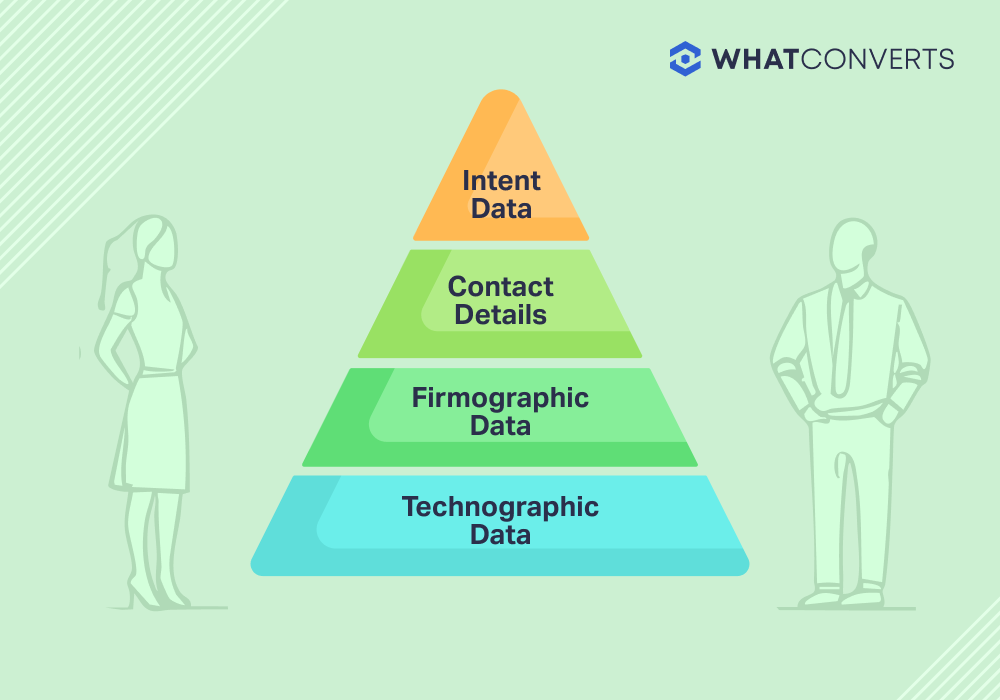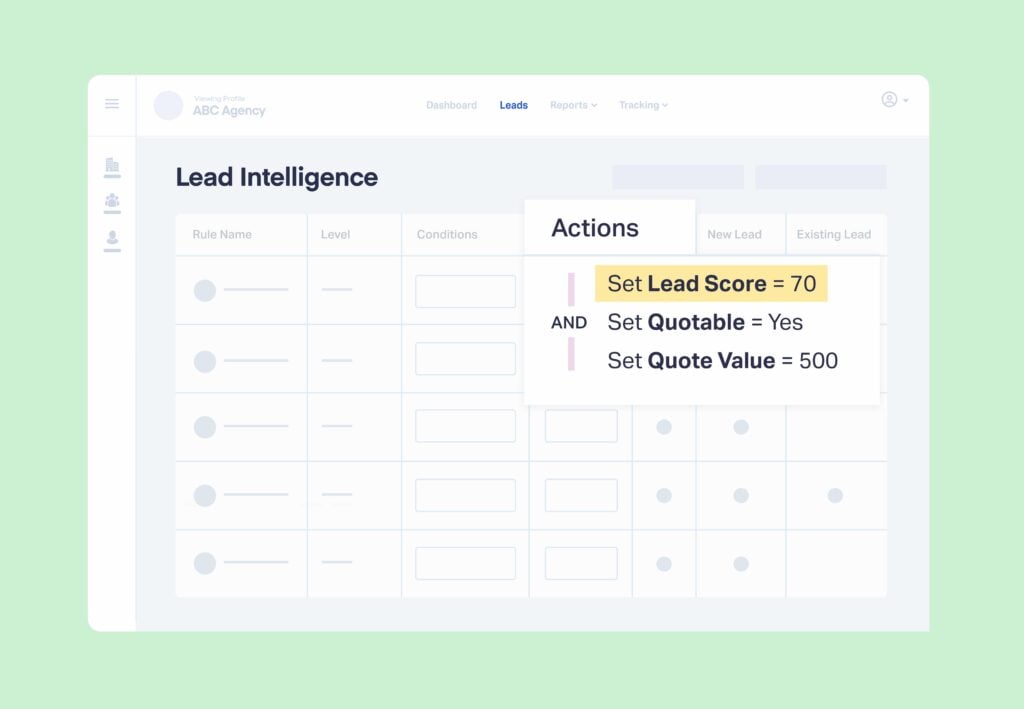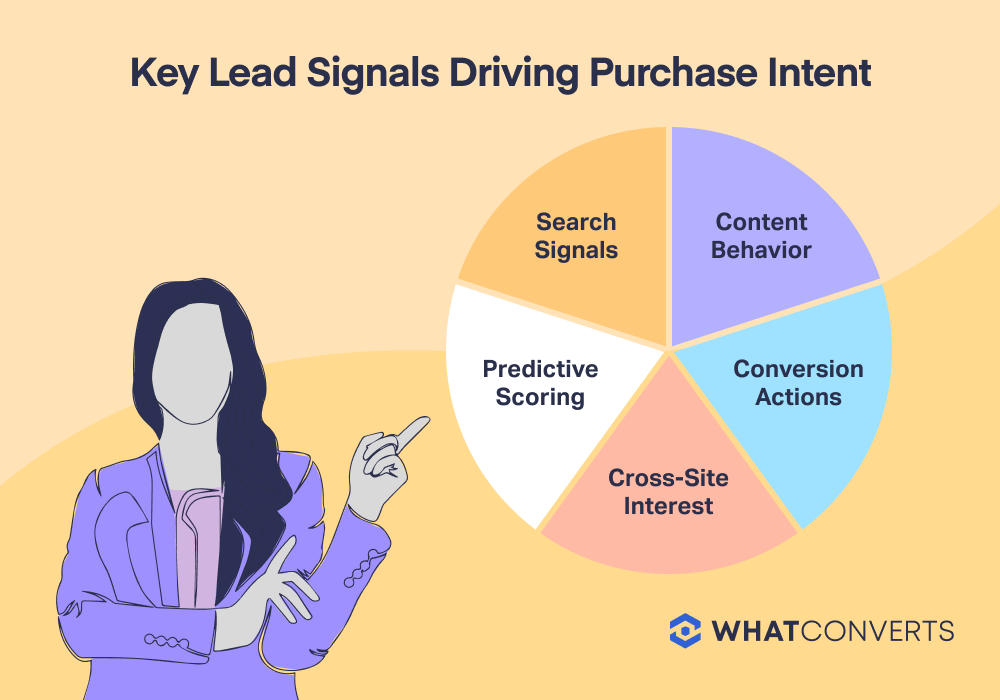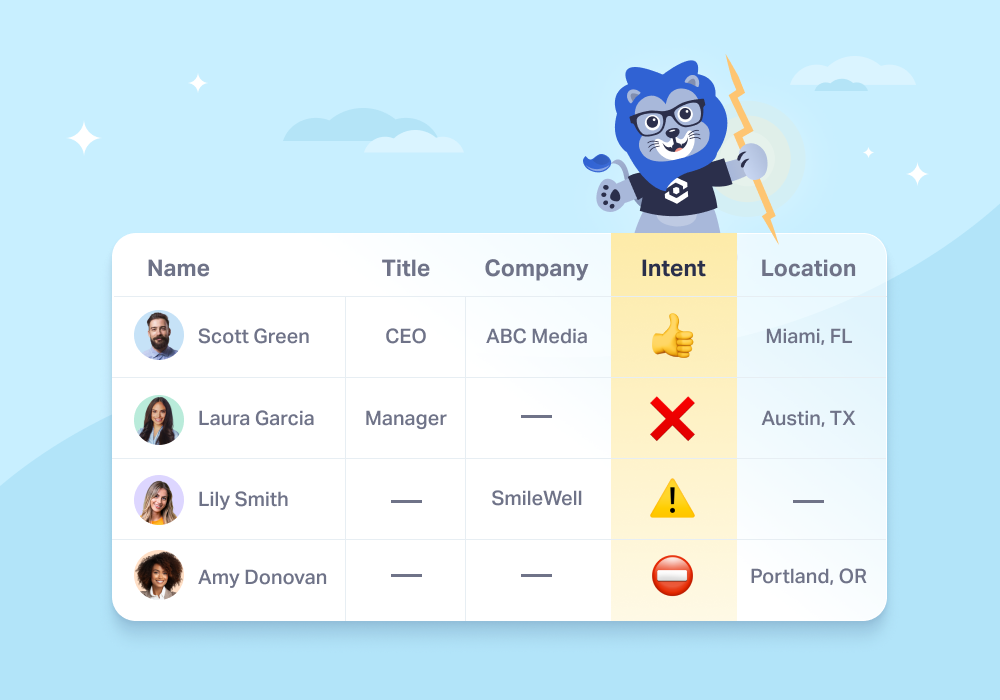
Most lead enrichment stops at the surface. Name, email, company size, and tech stack all give helpful context. But none of it answers the one question sales actually cares about: Is this prospect getting ready to buy?
That insight lives in intent data: behavioral signals (search queries, page views, pricing‑page visits, demo requests) that expose real purchase research as it happens. Marketers who layer intent data on top of basic contact fields see conversion rates jump by 40%, because reps can focus on leads that are both a fit and in‑market.
In this article, you’ll discover:
- The enrichment hierarchy. How contact, firmographic, and technographic data set the stage—but intent data closes the curtain.
- The signals that matter. Which intent cues actually correlate with revenue (and which are just digital noise).
- Where WhatConverts fits. Why WhatConverts is uniquely positioned to capture first‑party intent signals—search keywords, call transcripts, form submissions—and feed them straight into your attribution and scoring workflows.
Ready to turn anonymous clicks into a purchase‑ready pipeline? Let’s dive in.
Why Basic Contact Data Falls Short
Even the most pristine contact lists can leave sales teams chasing ghosts. Firmographic fit (industry, company size, seniority) tells you who a lead is. But it reveals nothing about whether they’re actually shopping. As one study notes, up to 70 % of B2B purchase decisions are made before contacting sales. Being able to capture the signals that show that journey is key.
The Limits of Firmographics and Demographics
- Fit ≠ intent. A Fortune 500 VP with zero research activity is statistically less likely to convert than a mid‑level manager actively comparing solutions—yet traditional scoring would flag the VP as the hotter lead.
- Blind to buying windows. Without behavioral context, you miss the moment an account moves from curiosity to true evaluation.
The Risk of Stale or Inaccurate Contact Info
- Rapid data decay. Titles change, companies reorganize, and emails go dark every quarter. One enrichment provider warns that lists just 3–6 months old can contain double‑digit bounce rates, hurting deliverability and wasting ad spend.
- Missed trigger events. If your database doesn’t capture real‑time shifts—like new funding or a tech‑stack overhaul—sales reps have no clue a prospect’s priorities just aligned with your solution.
Bottom line: Relying on static contact data is a recipe for low conversion efficiency. To surface high‑intent buyers, you need enrichment signals that move as fast as your prospects.
The Rise of Predictive Analytics and Intent‑Enriched Lead Scoring
Predictive analytics transforms scattered intent signals into a reliable forecast of revenue. By feeding search queries, content engagement, on‑site behavior, and technographic changes into a machine‑learning model, marketers can predict which leads are most likely to convert—and when.
How Intent Powers Predictive Enrichment
Traditional scoring models assign static points for role or company size. A predictive system recalculates scores whenever behavior changes: a prospect who downloads a pricing guide at 9 a.m. and returns to watch a demo at noon jumps straight to the top of the queue. Integrating these real‑time signals into your scoring means sales sees a continuously updated “probability to close” instead of yesterday’s guesswork.
For example, you can set up Lead Scoring rules in WhatConverts that up a prospect’s score as they interact with your content. Then, you can automatically send leads above a certain score to your sales team.
Proof It Works
- Adoption is surging. Gartner projects that 60% of B2B companies will use predictive analytics for lead generation by 2025.
- Conversion lift. Companies that add intent data to their scoring see an average 30% increase in conversions from the same lead volume.
- Shorter cycles. In one survey, 82 % of sellers said intent‑qualified leads close faster than traditional leads.
Takeaway: Predictive, intent‑enriched scoring turns enrichment from a static database into a living signal—helping marketing and sales focus on buyers ready to talk today.
5 High‑Impact Enrichment Signals (and How to Capture Them)
Not every data point moves the pipeline. The research highlights five signal categories that best predict purchase intent.
1. Search and Content Consumption Signals
Why it matters: According to MarketingProfs, 71 % of B2B buyers rely on content to inform purchase decisions, making every blog read, guide download, or webinar watched an early indicator of buying intent. When that same visitor repeatedly searches for pain‑point or comparison keywords, it’s a strong signal that their problem is urgent and they’re actively sizing up vendors.
Key signals to watch: Paid‑search keywords that triggered a call or form, deep reads of technical blog posts or guides, downloads of high‑value assets such as whitepapers or comparison checklists, and webinar registrations (especially high completion rates) all show the lead is moving from casual interest to committed research.
Resource: How to Find Your Best High Value, High Intent Keywords
How to capture and enrich
- Tap first‑party data — Deploy WhatConverts keyword tracking on paid campaigns to attach the exact query to every lead. You can also track high-intent conversions like product comparison downloads to highlight those ready-to-purchase prospects.
- Layer third‑party insight — Feed account‑level topic surges from providers like Bombora or G2 into your CRM, then combine them with first‑party events to raise scores before a visitor ever fills a form.
- Operationalize for sales — Surface a “Research depth” field that evaluates the customer journey, and trigger Slack or email alerts when a lead’s keyword + content engagement score crosses your high‑intent threshold. You can also use Lead Scoring features like the one in WhatConverts to do that.
Impact snapshot: Teams that enrich leads with these content signals report higher connect rates and faster deal cycles because reps can open with relevant context (“I saw you downloaded our ROI guide on X and watched our webinar. Happy to answer any follow‑up questions”).
2. Website Engagement and Technographic Shifts
Why it matters: Digital body language on your own site is often the clearest indicator that a prospect has moved from curiosity to evaluation. Repeated sessions, long dwell times, and deep dives into pricing, features, or case‑study pages all point to an internal discussion about budgets and vendor options. At the same time, shifts in a company’s tech stack (adding a complementary tool or dropping a competing platform) create timely openings for outreach.
Key signals to watch: Monitor the number of sessions in a rolling 7‑day window, time spent on high‑intent pages such as pricing or demo booking, and repeat views of comparison or integration docs. Pair these with technographic triggers like newly installed SaaS tools that integrate with yours, recent removals of competitor products, or job postings seeking experience with technologies you complement.
How to capture and enrich
- Instrument key pages — Use Lead Intelligence to create automations that automatically bump up Lead Score if a prospect lands on a service page and then visits a high-intent page like a case study.
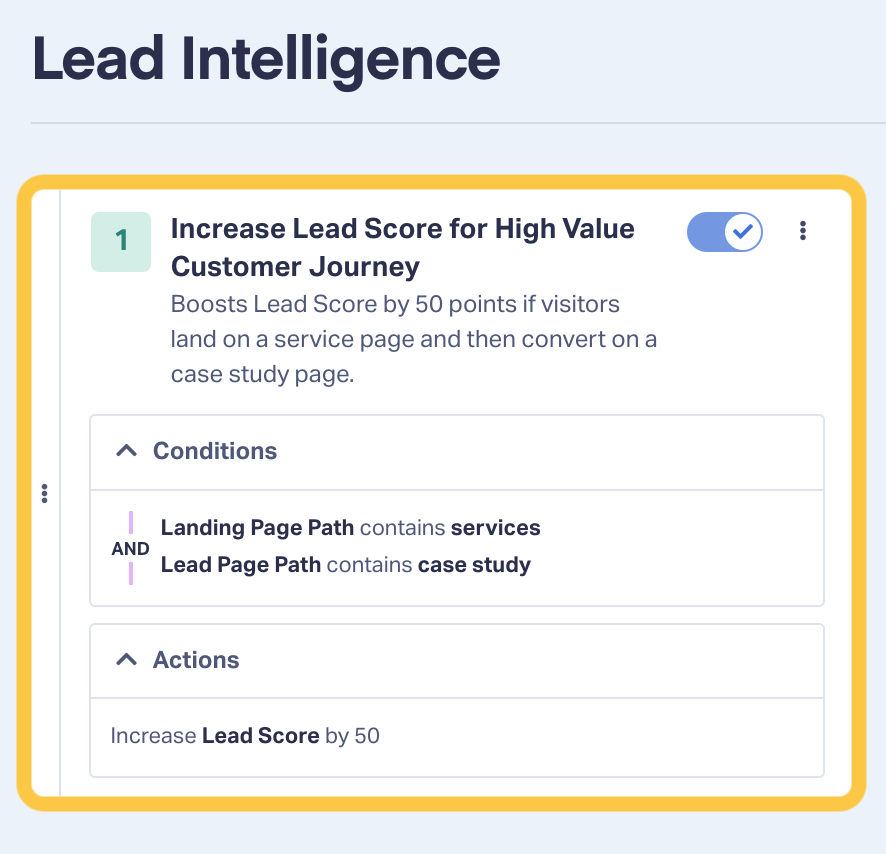
- Pull technographic feeds — Connect BuiltWith, Datanyze, or Clearbit Reveal to capture additions or removals in an account’s stack and append those events to lead records.
- Automate alerts — When a lead goes through a page-view journey and shows a fresh tech‑stack change, trigger a Slack or CRM alert so the account owner can reach out while interest is peaking.
Impact snapshot: Marketers who layer on‑site engagement with technographic shifts report dramatic lifts in win rates, as reps can time outreach around active evaluation phases and technology refresh cycles.
Resource: Lead Intelligence – The Smarter Way to Score, Qualify, & Value Your Leads
3. Hand-Raise Actions (Forms, Demo Requests)
Why it matters: When prospects volunteer their information—booking a demo, requesting a quote, or calling to ask about pricing—they’ve effectively raised their hand to enter a sales conversation. Deep‑dive research shows that demo requests carry the highest close rate of any lead source, converting at nearly 2X the rate and shortening the sales cycle by 30 % compared with leads who merely consume content.
Key signals to watch: Demo or trial sign‑ups, “talk to sales” form submissions, click‑to‑call events from pricing pages, chat sessions that mention budgets or timelines, and voicemail transcripts that reference implementation specifics all indicate a purchase timeline has begun.
How to capture and enrich
- Instant lead routing — Configure WhatConverts to tag form submissions with intent keywords (e.g., “demo,” “pricing,” “quote”) and push them to your CRM with a “Hot” lead status within seconds. Plus, you can trace those hot leads back to the exact marketing source that generated them.
- Call transcript mining — Enable automatic transcription in WhatConverts, then set keyword alerts for phrases like “budget approval” or “timeline” so SDRs know which callers to prioritize.
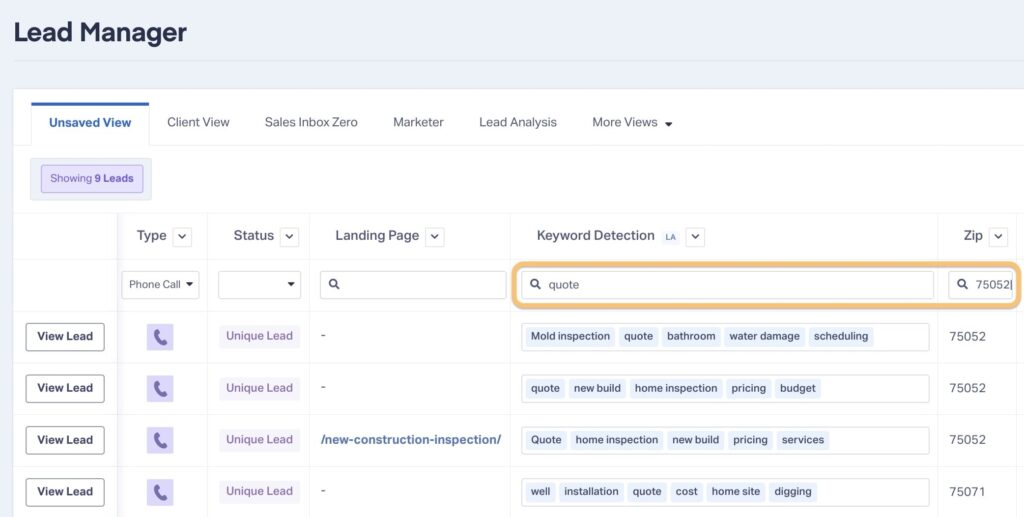
- Trial‑to‑deal tracking — For SaaS motions, link free‑trial activations captured by WhatConverts to the same lead ID so marketing can attribute which channels drive trials that convert to revenue.
Impact snapshot: Teams that build “hand‑raise fast lanes” report higher contact‑to‑meeting rates because reps respond within minutes while interest is highest. WhatConverts makes that speed possible by surfacing intent keywords and routing leads automatically.
Resource: How to Use AI Keyword Analysis to Supercharge Your Marketing
4. Third-Party Intent Surges
Why it matters: While first‑party data shows interest on your own properties, third‑party intent platforms like Bombora, G2, or TrustRadius surface research happening elsewhere on the web. A sudden spike in article reads, software comparisons, or review‑page views on topics you solve tells you an account is moving into active evaluation, even if they have never visited your site.
Key signals to watch: Topic “surge scores” that jump above the baseline for your solution category, increases in peer‑review traffic on comparison pages, and download spikes for analyst reports covering your market.
How to capture and enrich
- Subscribe to topic feeds — Set up Bombora or G2 buyer‑intent feeds for keywords aligned to your product and map the surge score to the matching account in your CRM.
- Blend with first‑party signals — Use WhatConverts to tag any inbound leads from that account with a “third‑party surge” flag so sales can see off‑site and on‑site intent in one view. You can easily see which leads come from third-party review sites like G2 and tag them manually or using automation.
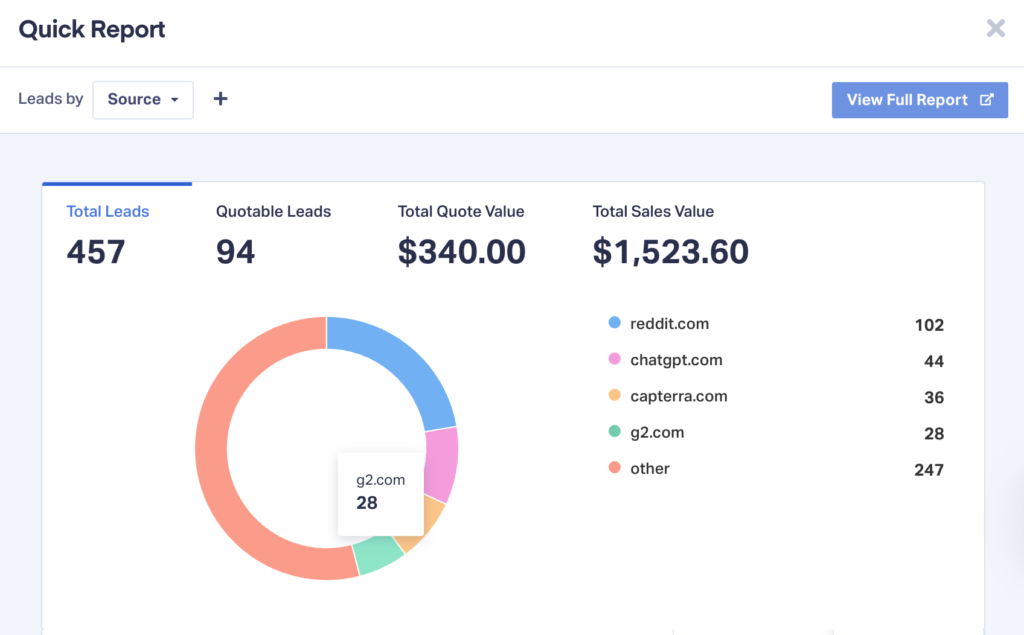
- Prioritize outreach windows — Create a rolling 14‑day window that keeps accounts in “surge status” while research is high, then auto‑downgrades once interest cools to avoid wasted calls.
Impact snapshot: Teams that combine surge data with WhatConverts can reach out at the precise moment prospects are reading comparisons and reviews.
Resource: Get Lightning-Fast Marketing Insights with Quick Reports
5. Fit + Intent Predictive Score
Why it matters: Combining firmographic fit with live intent signals produces the most accurate forecast of revenue. Teams that layer these dimensions into one score see lead quality jump by roughly 25 % and conversion rates climb correspondingly.
How the score works: Modern scoring engines add or subtract points in real time. That means a mid‑market manager who binges your pricing page can outrank an enterprise VP who never engages, ensuring sales stays focused on buyers, not titles.
How to capture and enrich
- Unify data streams — Pull firmographic fields from Clearbit or ZoomInfo while WhatConverts streams in keyword, call, and form data, so every record has both fit and intent inputs.
- Set weighting rules — Start simple (e.g., +10 for ICP fit, +20 for demo request, –5 after 30 days of no activity) and refine each quarter by analyzing which channels appear most often in closed‑won deals using WhatConverts attribution.
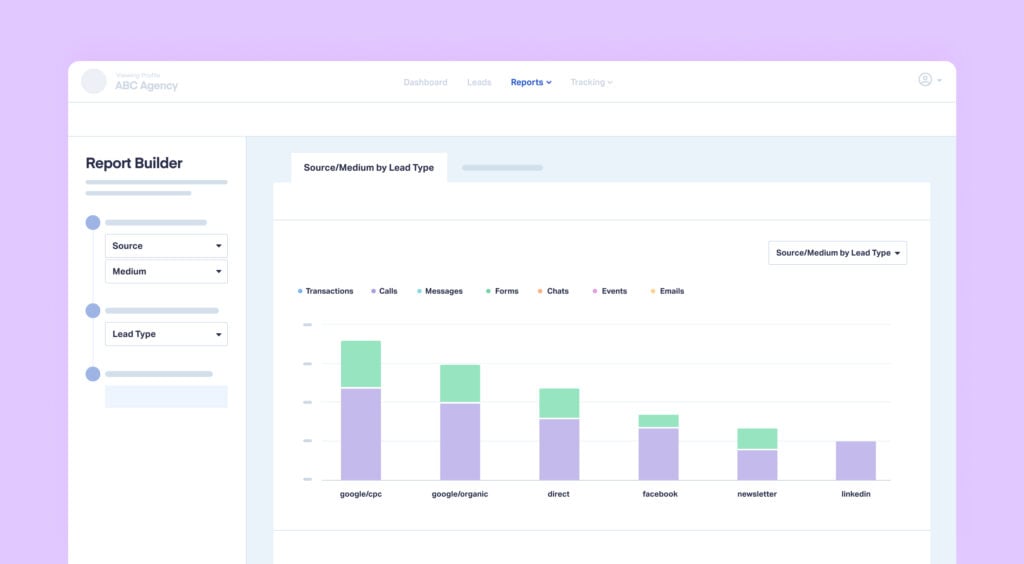
- Trigger actions by tier — Route “Tier A” scores directly to reps, funnel “Tier B” into nurture, and recycle “Tier C” if no new intent appears after 60 days.
Impact snapshot: Organizations that switch to a fit‑plus‑intent model report that top‑score leads convert better than low‑score leads and close noticeably faster, because reps stop chasing window‑shoppers and focus on in‑market buyers.
Resource: Pinpoint Your Best Channels with the Leads by Source Report
Conclusion: From Data to Revenue
Most enrichment stops at contact details. The teams that win layer fit, behavior, and real‑time intent into a single source of truth. When every lead record shows who the prospect is and how urgently they are buying, marketing can spend less time guessing, and sales can spend more time closing.
WhatConverts sits at the center of that workflow, capturing first‑party intent signals—keywords, calls, forms, and page paths—and piping them straight into your scoring and attribution model. The result is a pipeline full of leads that are both qualified and purchase‑ready.
Want to see which leads turn into revenue?
Start your free 14-day trial of WhatConverts today or book a demo with a product expert to see how we help prove and grow your ROI.
Get a FREE presentation of WhatConverts
One of our marketing experts will give you a full presentation of how WhatConverts can help you grow your business.
Schedule a Demo
Grow your business with WhatConverts






